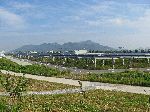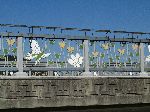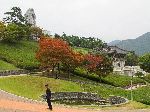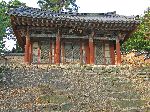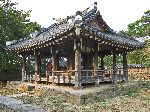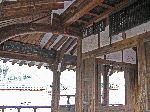Ibike Korea People-to-People Program
 Photo essay: West
Coast, South Korea -
Photo essay: West
Coast, South Korea -
Mokpo,
Hampyeong, Youngsan, Beopseong
Mokpo to Buan: We touch
coastline, see fishing village and breath sea air.
Points of Interest: Hampyeong, Yeomsan Christian Memorial Tower, Youngsan
Holy Land, Birthplace of Baekje Buddhism
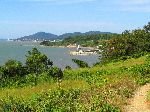
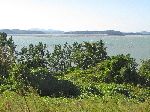
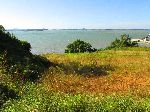 Staying
on the mainland, it takes miles to get out of Mokpo. Once you escape the urban
vortex the rural landscape quickly dominates and indication of the beauty of the
West Coast multiply.
Staying
on the mainland, it takes miles to get out of Mokpo. Once you escape the urban
vortex the rural landscape quickly dominates and indication of the beauty of the
West Coast multiply.There are wonderful views of the sea, but views of the open ocean are broken up by archipelagos of hundreds of islands.
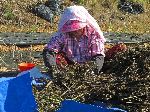
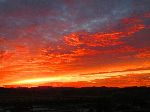 The
ocean is plied by fishermen, some of the tide flats are harvested for clams and
the upland areas are utilized for agriculture.
The
ocean is plied by fishermen, some of the tide flats are harvested for clams and
the upland areas are utilized for agriculture.This woman is cleaning her sesame seed (perilla) harvest (left).
If you are awake in time you might catch a spectacular sunrise (right).
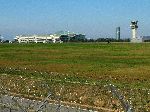
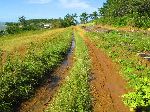 In
close proximity to each other are dirt roads (left), and Muan International
Airport (right).
In
close proximity to each other are dirt roads (left), and Muan International
Airport (right).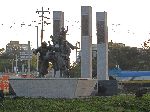
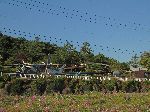 At
the south entrance to Hampyeong is an interest statue that seems to be some
troubadours with a cow. I was not able to figure out what is connects to.
At
the south entrance to Hampyeong is an interest statue that seems to be some
troubadours with a cow. I was not able to figure out what is connects to.
Seemingly similarly random is
the Muan Hodam
Aerospace Exhibition,
with an exhibition hall and a collection
of a dozen military aircraft on display, tucked up on a hillside near
Sanchang-ri, Mongtan-myeon, Muan-gun. There are jets, a C-123K transport planes
and helicopters in the yard. Some of the aircraft are from the Soviet Union and
North Korea. The site is nowhere near and air field or a battle site.
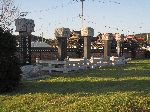
The story is it site was developed by former Air Force chief of staff Ok Man-ho for his hometown to nurture the children's love and dreams for aircraft.
Also in Sanchang is a well cared for monument in front of some traditional buildings, but it is all in Chinese (?) and not otherwise signed.
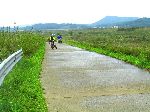
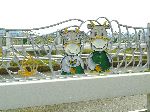 The Hampyeong
River flows past Hampyeong and into the Yeongsan River about 45km north of
Mokpo, but only about 6km from the coastline. For most of the 10km from
the town to the confluence, the adjacent dikes has been prepared as riverside recreation trails.
From the top of the dike the view is river on one side and farmland on the
other.
The Hampyeong
River flows past Hampyeong and into the Yeongsan River about 45km north of
Mokpo, but only about 6km from the coastline. For most of the 10km from
the town to the confluence, the adjacent dikes has been prepared as riverside recreation trails.
From the top of the dike the view is river on one side and farmland on the
other.The decoration on the guard rail for one of the bridges over the river is a happy cow theme.
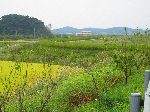
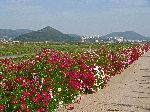
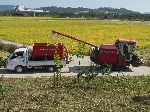
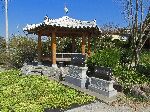
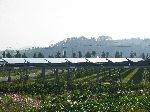
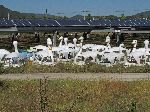 The
area adjacent to the river is primarily rural farm land, but over one field a large solar voltaic
systems has been installed -- probably at least 50 kwh -- and swan boats have a
dryland resting place, waiting for rescue -- they have been there a several years.
The
area adjacent to the river is primarily rural farm land, but over one field a large solar voltaic
systems has been installed -- probably at least 50 kwh -- and swan boats have a
dryland resting place, waiting for rescue -- they have been there a several years.
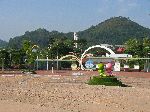
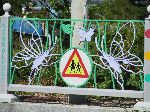
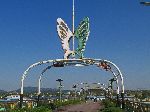
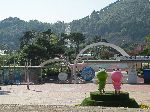 Hampyeong's Expo
Park was built in 2012.
It hosts at least two major annual events:
Hampyeong's Expo
Park was built in 2012.
It hosts at least two major annual events:The park hosts an annual Butterfly Festival in late April-early May. Not surprisingly, the butterfly is the symbol of the town and it appears in all kinds of locations, mediums and forms around town. A few insects like ladybugs, dung beetles and praying mantis also gets some visibility.
In late October-early November there is also a Chrysanthemum Festival in Hampyeong so a few Chrysanthemum-ish flowers also sneak into a few of the decorations.
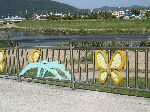
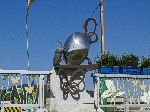
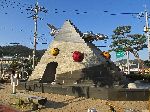
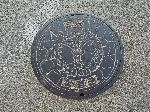
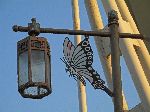
 Butterfly
and bug decorations appear in so many variation throughout the town that it
starts to feel a little over done, but overexposure and over-branding are not
conditions that theme obsessed Koreans would recognize.
Butterfly
and bug decorations appear in so many variation throughout the town that it
starts to feel a little over done, but overexposure and over-branding are not
conditions that theme obsessed Koreans would recognize.
To be fair, it is not all frou-frou butterflies in Hampyeong: There is a nice city center with health care, schools, restaurants, municipal offices, and well stocked retail stores (right).
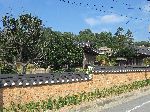
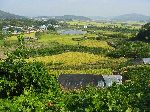
The Lee Jai-hyeok heritage house is near the center of Hampyeong. It was built by Lee dong-beom (1869-1940) of the Hampyeong Lee clan. He originally built two houses consisting of inner quarters and a Yukmo-jeong pavilion, but both were demolished to make way for a sarangchea (guest’s quarters) and a munganchea (servant’s quarters). Records reveal that the guest quarters was built in 1917, and the servants quarters, in 1929. The lore of the house says that once a Mr. Kim-gu kept himself out of sight for some time in a cave beneath the Yukmo-jeong during the day, and in a loft over the inner quarters during the night
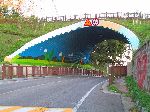
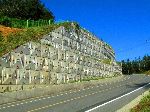 The
complete interior of a tunnel at the edge of Hampyeong is covered with a
cheerful mural (left).
The
complete interior of a tunnel at the edge of Hampyeong is covered with a
cheerful mural (left).
On a road through the coastal hills a retaining wall is decorated with colored dots in random order (right). The colored pieces might be some kind of nut cover or bolt cover, but someone thought to color them and install them in a playful way.
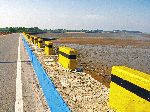
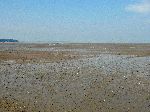 Heading
west, this shoreline area is known for Hampyeong’s ‘Haesujjim’, a
Heading
west, this shoreline area is known for Hampyeong’s ‘Haesujjim’, a
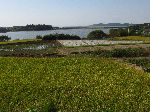 medical treatment method
that has been widely used ever since the 1800’s. Nutrients are added to
seawater, which is then heated for bathing, creating a “Haesujjim (seawater
bath)” that combines the benefits of hot springs and bathing. This is especially
popular among housewives since it is demonstrated to be an effective treatment for
neuralgia, post childbirth discomfort, arthritis, and dermatitis.
medical treatment method
that has been widely used ever since the 1800’s. Nutrients are added to
seawater, which is then heated for bathing, creating a “Haesujjim (seawater
bath)” that combines the benefits of hot springs and bathing. This is especially
popular among housewives since it is demonstrated to be an effective treatment for
neuralgia, post childbirth discomfort, arthritis, and dermatitis.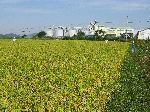
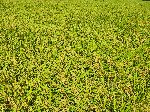
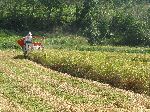 The
rice is ready. There is a tradition that rice is not cut until after Chuseok,
a harvest festival celebrated similar to North American thanksgiving. Chuseok is celebrated during the full moon that occurs
from the second week of September to the first week of October.
The
rice is ready. There is a tradition that rice is not cut until after Chuseok,
a harvest festival celebrated similar to North American thanksgiving. Chuseok is celebrated during the full moon that occurs
from the second week of September to the first week of October.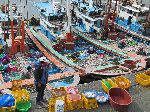
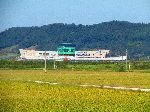
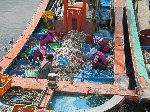 The
economic foundation of Seoldohang Port, Bongnam-ri, Yeomsan-myeon, is fishing.
The fishing boats and fish market are very active and draw a crowd of buyers.
The
economic foundation of Seoldohang Port, Bongnam-ri, Yeomsan-myeon, is fishing.
The fishing boats and fish market are very active and draw a crowd of buyers.
The market building has been designed to resemble a boat (far right).
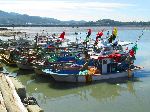
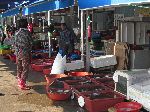
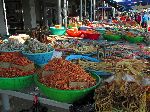
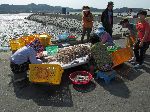
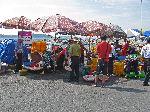
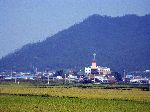
The Yeomsan Christian Memorial Tower is near the site of martyrdom of the 194 South Korean Christians who were buried at sea with large rocks tied around their necks. During the Korean War, in 1950, after the retaking of Seoul (Sept 28), the South Koreans were drowned in the sea by North Korean soldiers and communist guerillas who could not retreat. The legend is, that struggling, they sang religious hymns to the last moment. Elements of the monument include; the out stretched arms of Christ, three half-spheres (the trinity), and the crown thorns (suffering). The side murals depict events: Soldiers abusing civilians and imprisoning them with rocks tied to their bodies.
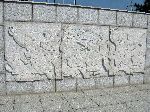
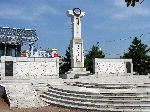
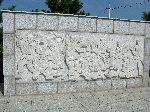
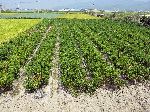
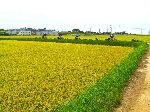 The
field (left) is pepper plants. Red peppers are used in gochujang
(paste) and other flavorings in Korean cuisine.
The
field (left) is pepper plants. Red peppers are used in gochujang
(paste) and other flavorings in Korean cuisine.Some of the most satisfy parts of bicycle touring in Korea is when the route follows farm roads through the fields (right).
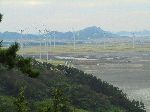
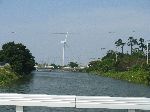
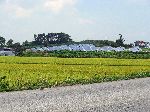 Other attractions in the area
are clean energy production project from wind (left) and solar voltaic (right).
Other attractions in the area
are clean energy production project from wind (left) and solar voltaic (right).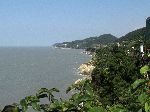
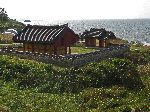
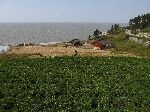 Between
Yeomsan and Beopseong there is a choice of routes; one spends more time on the
coast and the other goes more inland and passes the Youngsan Holy Land.
Between
Yeomsan and Beopseong there is a choice of routes; one spends more time on the
coast and the other goes more inland and passes the Youngsan Holy Land.The Baekje Coastal Road is quite dramatic in places and corresponding hillier.
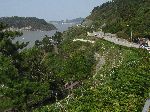
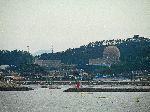
One of the anomalies of the coastal road is a view of the tip of the Hanbit Nuclear Power Plant (the name was changed from Yeonggwang NPP in 2013) (right). The plant was commissioned in 1986. The plants six reactors came on line between 1986 and 2002. It currently ranks as the fifth largest nuclear power station in the world. There is a bit of irony in the plants location 5km from the grounds of the shrines, temple and memorials to the founding of Baekje Buddhism. Korea has 23+ nuclear power reactors and more in the works.
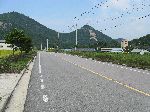
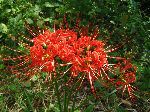
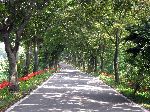 If
you arrive at the right time the native Lycoris Radiata, with its brilliant red
flowers and dramatic long stamen, will be in bloom along the road side. In
English they are also called hurricane lilies or cluster amaryllis. Like other
plants in the family Amaryllidaceae they are bulb-producing perennial plants.
If
you arrive at the right time the native Lycoris Radiata, with its brilliant red
flowers and dramatic long stamen, will be in bloom along the road side. In
English they are also called hurricane lilies or cluster amaryllis. Like other
plants in the family Amaryllidaceae they are bulb-producing perennial plants.
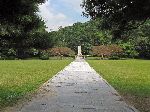
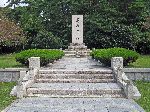
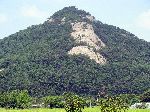 The
founding spirit of Won-Buddhism are; abolition of wastefulness, exclusion of superstition, elimination of illiteracy, prudence and
saving, and selfless sacrifice. The Great Master entered Nirvana on June 1, 1943
after transmitting the verse “Being changes in to Nonbeing and Nonbeing in to
Being, turning and turning again; but in the ultimate reality Being and
Non-being are both void, but the void is complete and contains everything.”
The
founding spirit of Won-Buddhism are; abolition of wastefulness, exclusion of superstition, elimination of illiteracy, prudence and
saving, and selfless sacrifice. The Great Master entered Nirvana on June 1, 1943
after transmitting the verse “Being changes in to Nonbeing and Nonbeing in to
Being, turning and turning again; but in the ultimate reality Being and
Non-being are both void, but the void is complete and contains everything.”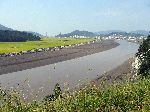
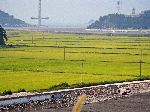
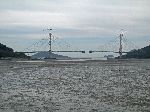
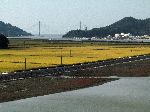
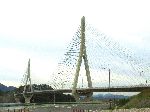
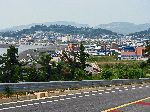
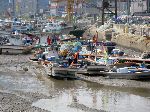
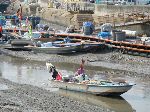
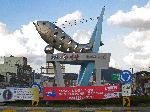 It is not surprising, given its location, that Beopseong is in part a fishing
and seafood processing town.
It is not surprising, given its location, that Beopseong is in part a fishing
and seafood processing town.
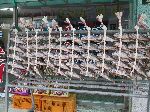
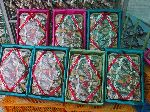
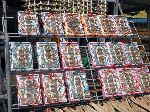
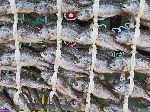 A
bit of a surprise were the gift boxes of dried fish
and fish on a ribbon. Dried fish is not a popular gift in North America.
A
bit of a surprise were the gift boxes of dried fish
and fish on a ribbon. Dried fish is not a popular gift in North America.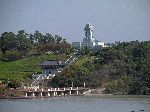
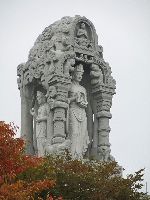
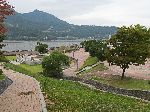 Beopseong
is called the Birthplace of Baekje Buddhism. It is said to be where an Indian Monk Mirananta (or Eastern China Monk Malandaa)
first set foot on Korean territory in 384 CE, to spread Buddhism, having made
his journey via Dongjin in China. In the Baekje Ungjin period (475 to 538) Buddhism developed
in earnest and it greatly flourished during the Sabi period (538 to 660) in particular.
Beopseong
is called the Birthplace of Baekje Buddhism. It is said to be where an Indian Monk Mirananta (or Eastern China Monk Malandaa)
first set foot on Korean territory in 384 CE, to spread Buddhism, having made
his journey via Dongjin in China. In the Baekje Ungjin period (475 to 538) Buddhism developed
in earnest and it greatly flourished during the Sabi period (538 to 660) in particular.
A large monument have been built on the hill west of town. In addition to an ornate pavilion and beautiful grounds, there are scores of carved monuments and statues of various styles.
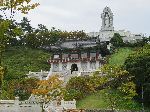
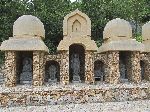
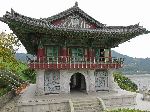
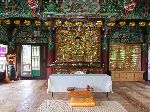
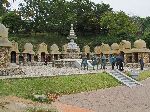
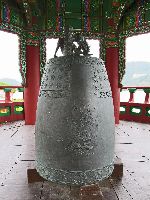
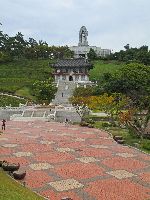
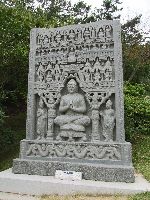
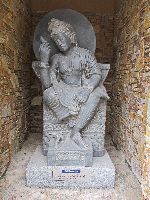
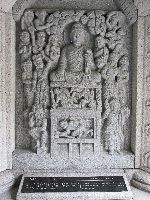
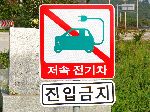
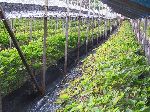 Continuing northeast, here are a couple of pictures of things along this road I am still trying to
learn something about:
Continuing northeast, here are a couple of pictures of things along this road I am still trying to
learn something about: The sign says electric cars are not welcome because of "low armature or plain"(?). Is this connected to the Daema Electric Vehicle Industry, a few miles east, near Yeonggwang?
Of more certainty is a roadside ginseng farm. The crop had been rare for a while, but this area has a large number of ginseng growers.
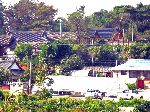
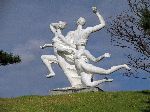 On the
left is Doam Seowon. This would make it an old Confucius school, but its history and story have eluded me so far.
On the
left is Doam Seowon. This would make it an old Confucius school, but its history and story have eluded me so far.
And then at the entrance to Mujang is an interesting statue (right) but its significance is yet to be determined.
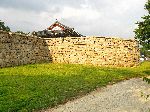
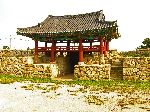
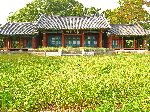
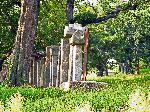
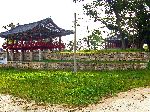
During the Joseon Period, central government officials and foreign envoys stayed at the walled Mujang Guesthouse / Town Fortress or Castle, when they paid a visit to Mujang-myeon, Gochang-gun. The letter ‘gwol’ inscribed on the wooden plaque hung at the main hall, symbolizes the king. The local officials paid homage to the wooden plaque on the first and 15th of each month. Whenever there was a national celebration, people gather here to perform a rite. It is assumed that the building was built in 1581. The main building has three parts. The central hall was built higher to enhance its status, as a place containing the symbol of the king. The figures of a tiger and clouds carved on the stairs, add to the esthetic quality of the building.
Every stretch of roads has more history and stories -- and they go back centuries.
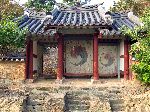
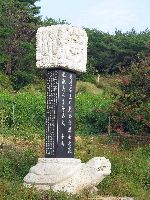 Deokcheon
Seowon is a memorial to Cho Chik (1501-72). Cho Chik, a Confucian
scholar, was born in Samga, Hapcheon-gun, during the reign of the King Yunsan-gun
(r.1494-1506). When offered a magistrate's position, he declined so he could
continue to teach local students at this site. The memorial was built by
Confucian scholars in 1576 during the reign of King Songjo (r.1567-1608). Along
with other Confucian shrines and memorial halls, it closed at the end of
the 19th century by order of the Regent Taewon-gun. It re-opened in the 1930s.
Deokcheon
Seowon is a memorial to Cho Chik (1501-72). Cho Chik, a Confucian
scholar, was born in Samga, Hapcheon-gun, during the reign of the King Yunsan-gun
(r.1494-1506). When offered a magistrate's position, he declined so he could
continue to teach local students at this site. The memorial was built by
Confucian scholars in 1576 during the reign of King Songjo (r.1567-1608). Along
with other Confucian shrines and memorial halls, it closed at the end of
the 19th century by order of the Regent Taewon-gun. It re-opened in the 1930s.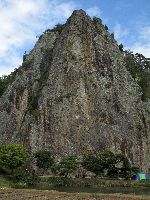
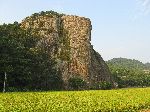 Incheongangbyeon-ro,
through Wonpyeong-gil reveals additional variations in the kind of landscape in the area.
The shear rock cliffs in at Yonggye-ri, Asan-myeon, Gochang-gun is popular among
climbers (enlarge the thumbnail to the left and you can find a couple of human
specs climbing in the lower left quarter of the wall). Climbers here have cut
scores of hand and foot holds in the rock, this would be extraordinarily frowned
upon in the North America climbing communities.
Incheongangbyeon-ro,
through Wonpyeong-gil reveals additional variations in the kind of landscape in the area.
The shear rock cliffs in at Yonggye-ri, Asan-myeon, Gochang-gun is popular among
climbers (enlarge the thumbnail to the left and you can find a couple of human
specs climbing in the lower left quarter of the wall). Climbers here have cut
scores of hand and foot holds in the rock, this would be extraordinarily frowned
upon in the North America climbing communities.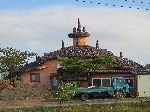
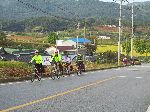
And the alternative route around the west side of the Seonunsan (mountains), through Palhyeongchi-gil (right) provides a different collecting of visual experiences and some glimpses of the sea..
 Please
contact us if you would like to be added to
Ibike's mailing list or have questions, comments, corrections or criticism. (Also, please let us know how you learned about us and
found this site.) Privacy policy.
Please
contact us if you would like to be added to
Ibike's mailing list or have questions, comments, corrections or criticism. (Also, please let us know how you learned about us and
found this site.) Privacy policy.
![]() IBF Homepage
IBF Homepage ![]() Ibike Programs
Ibike Programs
![]() Ibike Schedule
Ibike Schedule
![]() Search
Search
